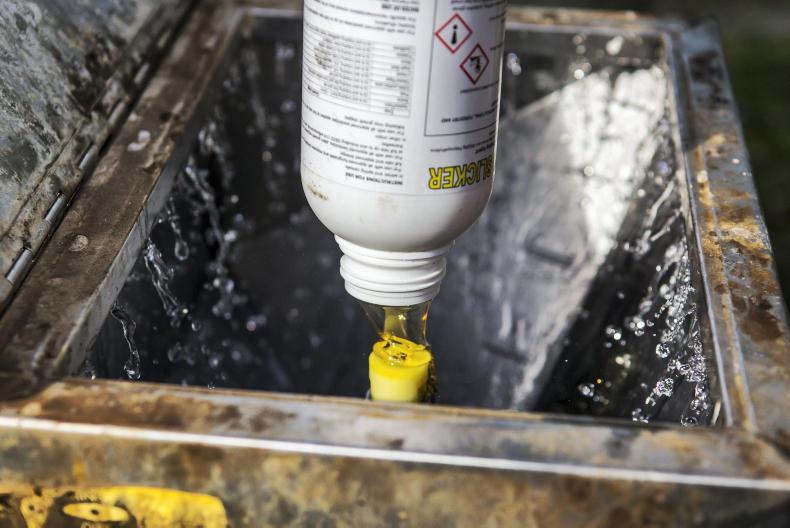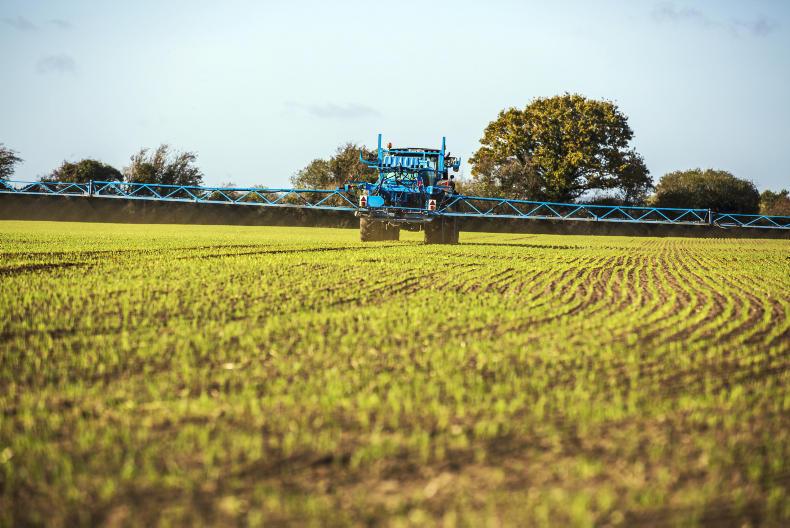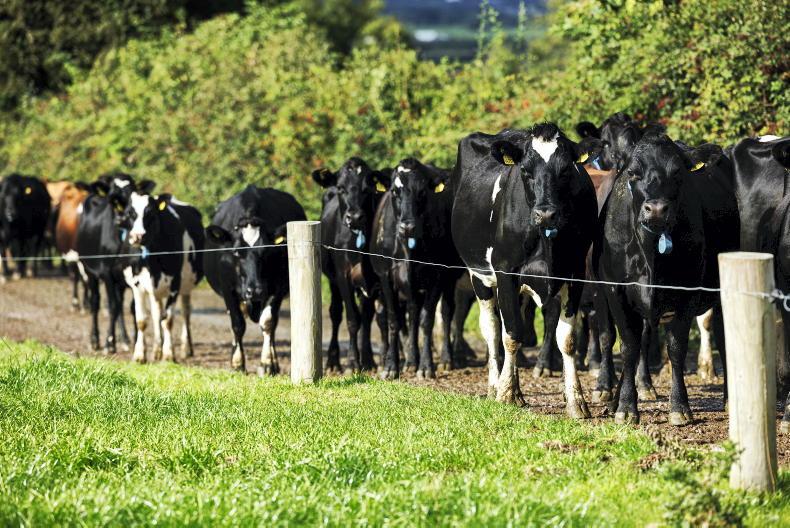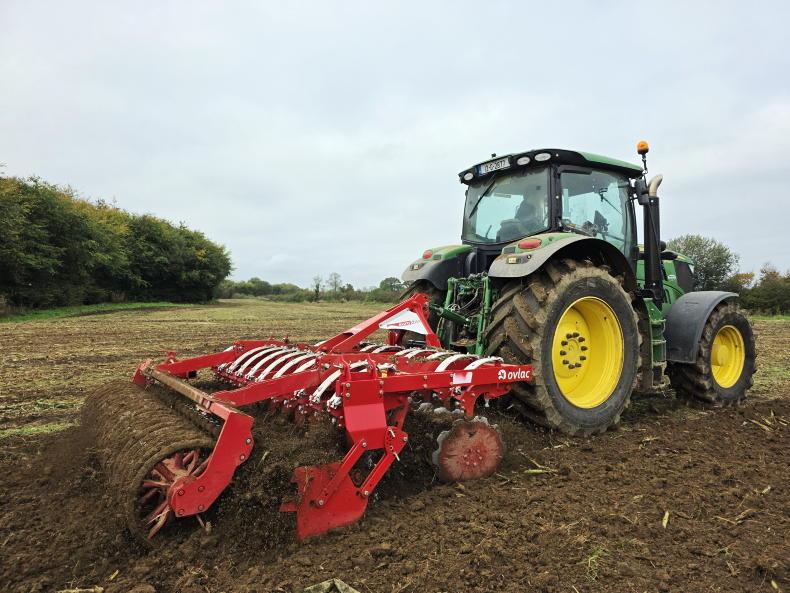It seems inevitable that 2019 will go down as a year of substantial change in the world of crop protection in Ireland. The impact of the Sustainable Use Directive and all its associated provisions are beginning to bite. The decision has recently been made to revoke chlorothalonil in the EU and that will have significant implications for Irish producers. But it seems like we will have the active for this year and possibly 2020 also. But we will face into the autumn of 2019 without the help of clothianidin (Deter) to help protect early sown crops against BYDV infection.
In essence, 2019 may mark the end, or the beginning of the end, for quite a number of actives that have been important in the market here on this island. We will see Diquat go, as well as the neonics, and we are that bit closer to losing the bulk of our long-serving triazoles. But we also hope that 2019 will be the year which begins to herald the arrival of a number of new actives into the market from 2020 onwards. And we must hope that there will be enough of these to help protect each other in the absence of actives such as chlorothalonil.
In an autumn that saw plentiful mildew infection on many winter cereal crops, we must be aware of the fact that fenpropimorph will also leave the market at the end of October 2020. The active will not be reregistered because BASF is not supporting its re-registration. This is an intermittent annual market and the economics obviously do not stack up for the company.
There will also be other actives that will not be supported by the main company because generics have depressed the price to the point that no one is willing to invest in the cost of re-registration.
New actives
The first of these to clear the registration hurdle is Revysol from BASF. It has already received registration in the UK, which was the rapporteur country, but, from what I understand, it may still not be on sale there to any degree during 2019. At the Teagasc tillage conference earlier this year, Steven Kildea gave a brief mention of a number of the new actives in development. These included Revysol (BASF) and Inatreq (Corteva), both of which are expected in 2020. Then there was Adepidyn (Syngenta) and Pavecto (BASF), which are expected around 2022. Another, Adavelt (Corteva), is targeted for around 2024.
Some of these actives are completely new fungicide families, while others are variants of existing families that currently show differing control characteristics. There are other fungicide actives in the pipeline also from other manufacturers, but unless some of them prove to be extraordinarily robust, we may still be looking at the beginning of a new battle which nature will win. The best we can hope for is that the combination of good use advice in conjunction with sharp monitoring and the adoption of research will delay the inevitable. And growers will be both in the front line and vanguard of that battle.
A need to sharpen husbandry
To give them a fighting chance, one of the key things that must change is the adoption of husbandry choices which significantly reduce disease pressure. While we all accept that frequency of use is an important factor in driving resistance, so is the level of disease present in a crop ahead of application. So everything we can do to reduce disease pressure is a plus in terms of minding our fungicides.
We can do this to some degree for septoria in wheat because we know many of the variables that lead to increased disease pressure. But ramularia in barley may be an even greater threat as, from what we know about its disease cycle, it has adapted to overcome many of our standard husbandry mechanisms. Up to relatively recently, there was little known about this disease, but this has changed in recent years. While there is still a lot to be learned, what is known is included in an article by Prof Fiona Burnett on pages 10 to 12 of this publication.
It is also important for us all to realise that a significant change in the understanding or development pattern of any other of our existing diseases, or indeed a totally new disease, can emerge to raise our plant protection requirements even higher than they are today.
For many years in this publication I have stated that we are coming to the end of the chemical era in plant protection. That is not to suggest that it will cease totally, but rather that we will have to combine our limited control tools with any and every other element of husbandry that will reduce overall disease pressure, because the lower the pressure, the less the risk of resistance development.

We are likely to see considerable change in the products we put in our sprayers in the next two to three years. Philip Doyle
The risk of resistance development is parallelled by frequency of use. So it is hardly surprising that we are where we find ourselves today. But can we realistically use fewer products less often and still achieve optimum disease control? That is a major challenge and would require a major change in attitude, but failure to adapt may have a far greater impact on the sector than the other challenges that exist today.
IPM is good farming practice
We are all witnessing the increased reference and exposure to concepts such as integrated pest management or similar phrases, but, ultimately, these all come back to one common denominator – good farming practice. What was good farming practice 40 years ago is still good farming practice today. Doing things that reduce the risk of a problem may result in a saving and failure to do that over the past four decades saw our costs rise while product prices did not follow suit.
One can rightly ask what contribution our rules and regulations have made to the situation we find ourselves in today. The obligation to have green cover over winter certainly helped carry diseases and pests through the full calendar year and pests such as aphids became a bigger cost and a bigger concern. The obligation to have green cover will not go away because it does contribute to some degree to the prevention of nutrient loss, but perhaps farmers will realise the multiple benefits that catch and cover crops bring to tillage farming while reducing this green bridge effect from volunteer-only vegetation.
Good farming practice means thinking about everything one does and preferably long before it’s time to do it. This can help bring about many changes to current practice and it can also completely remove the need for certain categories of inputs. Where zero tolerance has been the approach to grass weeds, there is no annual control cost. Annual shallow stubble cultivation can virtually remove slugs as a problem, which can be very useful where either oilseed rape or potatoes are being grown.
IPM can be seen as something we are obliged to do, but good farming practice should be something we want to do for our own benefit. Given the overall situation in tillage today, we have to find ways to minimise risk and to remove as many costs as possible while still managing to increase yields closer to the potential of modern genetics. These two objectives may seem contradictory, but for a number of decades bag or bottle solutions were by far the easiest option and they were economically feasible when those products worked.
What might be the contribution that good soil health could bring towards reducing some of the problems we are experiencing today? Could the billions or trillions of soil organisms in each cubic metre of healthy soil contribute directly or indirectly towards minimising infection pressure from some or all foliar diseases?
Resistance and politics
The situation has now changed considerably and farmers, in general, are aware of the fightback from nature, whether that be pest resistance or antibiotic resistance. For crop producers, resistance is an increasing reality, especially in conjunction with specific diseases, pests and weeds. As has been said by many commentators over the past few years, risk of resistance development is paralleled by usage level. And as intensive users of inputs, we incur both the cost and the risk simultaneously.
Perhaps the ultimate warning of the need for good farming practice lies in the fact that we now see resistance development in some grass weeds to glyphosate. This active has always been viewed as the fail-safe for control, but when the active itself and its control capability are under threat, it is time to look in a different direction, at least some of the time.
We see the increasing influence of politics on an almost monthly basis. This was perhaps at its worst in the case of the registration of glyphosate and these pressures have not gone away. Whether we like it or not, society in general is exerting substantial pressure on the rules and regulations that are affecting all aspects of agriculture.
Real disease control threats
On the disease front, septoria, net blotch and ramularia continue to be a serious worry. Ramularia has managed to crack almost every active within a few years of use and there is little to suggest that this will not continue into the future. The major exception was chlorothalonil which stood the test of time, but this will soon be gone. The question now is will new or alternative actives control the disease effectively and will they prove durable over time. This is a critical issue for barley production.
Septoria is no less of a threat for wheat producers. Assessment at Teagasc Oak Park has identified that a strain is now increasing which is quite resistant to all SDHI actives. That is a real worry, especially given that we have had two consecutive years of relatively low disease pressure. It is equally of interest to note that this strain has been expanding across much of Europe, but, so far at least, its incidence within those populations appears to have remained relatively low.
There are suggestions that this particular strain of septoria may be less fit and that this may continue to inhibit its expansion within populations and so limit the development and significance of this resistance. Different companies and organisations have varying views on this topic and these can be conflicting. This makes it difficult to interpret the consequences of this ongoing evolution.
Independent resistance advice
For the past few decades, resistance monitoring and development has been marshalled by the Fungicide Resistance Action Committee (FRAC). This largely comprises of manufacturing companies that have skin in the game and that have to make decisions which may be a compromise between advice and commercial realities. As the complexities of resistance increase, it would seem that there is considerable disagreement on matters relating to resistance issues, especially with SDHI fungicides, and one must wonder if this affecting advice.
Is it time for the industry to consider a separate independent body to research and overview this increasingly important topic? While one must acknowledge that the companies have at least as much expertise as any combined independent organisations and that decisions must take into account commercial realities as well as pathogen epidemiology, the credibility of advice will be tarnished when different viewpoints are expressed publicly.
It seems inevitable that 2019 will go down as a year of substantial change in the world of crop protection in Ireland. The impact of the Sustainable Use Directive and all its associated provisions are beginning to bite. The decision has recently been made to revoke chlorothalonil in the EU and that will have significant implications for Irish producers. But it seems like we will have the active for this year and possibly 2020 also. But we will face into the autumn of 2019 without the help of clothianidin (Deter) to help protect early sown crops against BYDV infection.
In essence, 2019 may mark the end, or the beginning of the end, for quite a number of actives that have been important in the market here on this island. We will see Diquat go, as well as the neonics, and we are that bit closer to losing the bulk of our long-serving triazoles. But we also hope that 2019 will be the year which begins to herald the arrival of a number of new actives into the market from 2020 onwards. And we must hope that there will be enough of these to help protect each other in the absence of actives such as chlorothalonil.
In an autumn that saw plentiful mildew infection on many winter cereal crops, we must be aware of the fact that fenpropimorph will also leave the market at the end of October 2020. The active will not be reregistered because BASF is not supporting its re-registration. This is an intermittent annual market and the economics obviously do not stack up for the company.
There will also be other actives that will not be supported by the main company because generics have depressed the price to the point that no one is willing to invest in the cost of re-registration.
New actives
The first of these to clear the registration hurdle is Revysol from BASF. It has already received registration in the UK, which was the rapporteur country, but, from what I understand, it may still not be on sale there to any degree during 2019. At the Teagasc tillage conference earlier this year, Steven Kildea gave a brief mention of a number of the new actives in development. These included Revysol (BASF) and Inatreq (Corteva), both of which are expected in 2020. Then there was Adepidyn (Syngenta) and Pavecto (BASF), which are expected around 2022. Another, Adavelt (Corteva), is targeted for around 2024.
Some of these actives are completely new fungicide families, while others are variants of existing families that currently show differing control characteristics. There are other fungicide actives in the pipeline also from other manufacturers, but unless some of them prove to be extraordinarily robust, we may still be looking at the beginning of a new battle which nature will win. The best we can hope for is that the combination of good use advice in conjunction with sharp monitoring and the adoption of research will delay the inevitable. And growers will be both in the front line and vanguard of that battle.
A need to sharpen husbandry
To give them a fighting chance, one of the key things that must change is the adoption of husbandry choices which significantly reduce disease pressure. While we all accept that frequency of use is an important factor in driving resistance, so is the level of disease present in a crop ahead of application. So everything we can do to reduce disease pressure is a plus in terms of minding our fungicides.
We can do this to some degree for septoria in wheat because we know many of the variables that lead to increased disease pressure. But ramularia in barley may be an even greater threat as, from what we know about its disease cycle, it has adapted to overcome many of our standard husbandry mechanisms. Up to relatively recently, there was little known about this disease, but this has changed in recent years. While there is still a lot to be learned, what is known is included in an article by Prof Fiona Burnett on pages 10 to 12 of this publication.
It is also important for us all to realise that a significant change in the understanding or development pattern of any other of our existing diseases, or indeed a totally new disease, can emerge to raise our plant protection requirements even higher than they are today.
For many years in this publication I have stated that we are coming to the end of the chemical era in plant protection. That is not to suggest that it will cease totally, but rather that we will have to combine our limited control tools with any and every other element of husbandry that will reduce overall disease pressure, because the lower the pressure, the less the risk of resistance development.

We are likely to see considerable change in the products we put in our sprayers in the next two to three years. Philip Doyle
The risk of resistance development is parallelled by frequency of use. So it is hardly surprising that we are where we find ourselves today. But can we realistically use fewer products less often and still achieve optimum disease control? That is a major challenge and would require a major change in attitude, but failure to adapt may have a far greater impact on the sector than the other challenges that exist today.
IPM is good farming practice
We are all witnessing the increased reference and exposure to concepts such as integrated pest management or similar phrases, but, ultimately, these all come back to one common denominator – good farming practice. What was good farming practice 40 years ago is still good farming practice today. Doing things that reduce the risk of a problem may result in a saving and failure to do that over the past four decades saw our costs rise while product prices did not follow suit.
One can rightly ask what contribution our rules and regulations have made to the situation we find ourselves in today. The obligation to have green cover over winter certainly helped carry diseases and pests through the full calendar year and pests such as aphids became a bigger cost and a bigger concern. The obligation to have green cover will not go away because it does contribute to some degree to the prevention of nutrient loss, but perhaps farmers will realise the multiple benefits that catch and cover crops bring to tillage farming while reducing this green bridge effect from volunteer-only vegetation.
Good farming practice means thinking about everything one does and preferably long before it’s time to do it. This can help bring about many changes to current practice and it can also completely remove the need for certain categories of inputs. Where zero tolerance has been the approach to grass weeds, there is no annual control cost. Annual shallow stubble cultivation can virtually remove slugs as a problem, which can be very useful where either oilseed rape or potatoes are being grown.
IPM can be seen as something we are obliged to do, but good farming practice should be something we want to do for our own benefit. Given the overall situation in tillage today, we have to find ways to minimise risk and to remove as many costs as possible while still managing to increase yields closer to the potential of modern genetics. These two objectives may seem contradictory, but for a number of decades bag or bottle solutions were by far the easiest option and they were economically feasible when those products worked.
What might be the contribution that good soil health could bring towards reducing some of the problems we are experiencing today? Could the billions or trillions of soil organisms in each cubic metre of healthy soil contribute directly or indirectly towards minimising infection pressure from some or all foliar diseases?
Resistance and politics
The situation has now changed considerably and farmers, in general, are aware of the fightback from nature, whether that be pest resistance or antibiotic resistance. For crop producers, resistance is an increasing reality, especially in conjunction with specific diseases, pests and weeds. As has been said by many commentators over the past few years, risk of resistance development is paralleled by usage level. And as intensive users of inputs, we incur both the cost and the risk simultaneously.
Perhaps the ultimate warning of the need for good farming practice lies in the fact that we now see resistance development in some grass weeds to glyphosate. This active has always been viewed as the fail-safe for control, but when the active itself and its control capability are under threat, it is time to look in a different direction, at least some of the time.
We see the increasing influence of politics on an almost monthly basis. This was perhaps at its worst in the case of the registration of glyphosate and these pressures have not gone away. Whether we like it or not, society in general is exerting substantial pressure on the rules and regulations that are affecting all aspects of agriculture.
Real disease control threats
On the disease front, septoria, net blotch and ramularia continue to be a serious worry. Ramularia has managed to crack almost every active within a few years of use and there is little to suggest that this will not continue into the future. The major exception was chlorothalonil which stood the test of time, but this will soon be gone. The question now is will new or alternative actives control the disease effectively and will they prove durable over time. This is a critical issue for barley production.
Septoria is no less of a threat for wheat producers. Assessment at Teagasc Oak Park has identified that a strain is now increasing which is quite resistant to all SDHI actives. That is a real worry, especially given that we have had two consecutive years of relatively low disease pressure. It is equally of interest to note that this strain has been expanding across much of Europe, but, so far at least, its incidence within those populations appears to have remained relatively low.
There are suggestions that this particular strain of septoria may be less fit and that this may continue to inhibit its expansion within populations and so limit the development and significance of this resistance. Different companies and organisations have varying views on this topic and these can be conflicting. This makes it difficult to interpret the consequences of this ongoing evolution.
Independent resistance advice
For the past few decades, resistance monitoring and development has been marshalled by the Fungicide Resistance Action Committee (FRAC). This largely comprises of manufacturing companies that have skin in the game and that have to make decisions which may be a compromise between advice and commercial realities. As the complexities of resistance increase, it would seem that there is considerable disagreement on matters relating to resistance issues, especially with SDHI fungicides, and one must wonder if this affecting advice.
Is it time for the industry to consider a separate independent body to research and overview this increasingly important topic? While one must acknowledge that the companies have at least as much expertise as any combined independent organisations and that decisions must take into account commercial realities as well as pathogen epidemiology, the credibility of advice will be tarnished when different viewpoints are expressed publicly.










SHARING OPTIONS